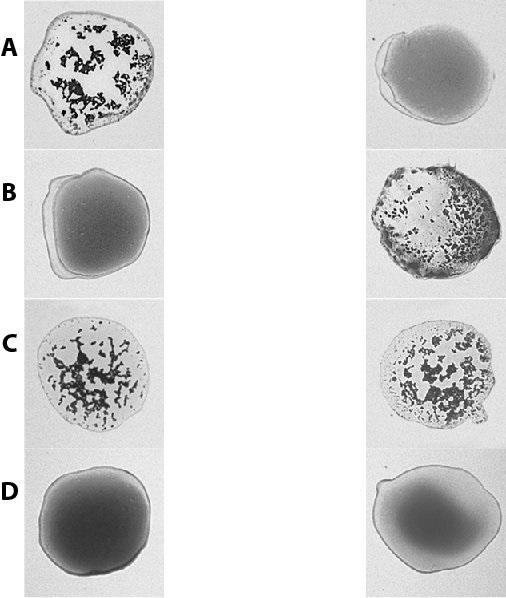1-Which of the following is not one of the functions of blood?
to protect vital organs
to transport and exchange gases
to maintain body temperature
blood clotting
to protect vital organs
2- The most abundant component of plasma is:
water.
proteins.
gases.
ions.
water
3-Which of the following characteristics is not associated with
erythrocytes?
Biconcave discs
Filled with hemoglobin
Anucleate
Capable of protein synthesis
Capable of protein synthesis
4-What is the oxygen-binding protein found in erythrocytes?
hemoglobin
albumin
gamma globulin
beta globulin
hemoglobin
5-Bilirubin comes from the breakdown of:
heme molecules of hemoglobin that lack iron.
amino acids
of hemoglobin.
iron ions found in hemoglobin molecules.
globin chains of hemoglobin.
heme molecules of hemoglobin that lack iron.
6-During leukopoiesis, neutrophils are derived from __________.
proerythroblasts
lymphoblast
myeloblasts
monoblasts
myeloblasts
7-Which type of leukocyte may produce antibodies?
lymphocyte
neutrophil
monocyte
eosinophil
lymphocyte
8-Which of the following characteristics is not associated with
platelets?
They do not have a nucleus.
They contain granules with
clotting factors and enzymes.
They are cell fragments.
They are incapable of oxidative catabolism.
They are incapable of oxidative catabolism.
9-The enzyme that coverts fibrinogen to fibrin is __________.
thrombin
tissue factor
prothrombin
factor Xa
thrombin
10-Select the appropriate pathway for the steps of hemostasis.
vascular spasms, platelet plug formation, coagulation,
thrombolysis, clot retraction
platelet plug formation, vascular
spasms, coagulation, clot retraction, thrombolysis
vascular
spasms, platelet plug formation, coagulation, clot retraction,
thrombolysis
vascular spasms, coagulation, platelet plug
formation, clot retraction, thrombolysi
vascular spasms, platelet plug formation, coagulation, clot retraction, thrombolysis
11-In the common pathway of coagulation, what factor combines with
factor Va and calcium ions to form prothrombin activator?
VIIa
IXa
Xa
XIIa
Xa
12-Which of the following donors will be suitable for a recipient
with type A+ blood?
A donor with AB+ blood
A donor with AB- blood
A
donor with B+ blood
A donor with O- blood
A donor with O- blood 13-

13-Match the following blood types. In the left column, the blood sample is combined with an anti-A antibody; in the right column, the blood sample is combined with an anti-B antibody.
Type AB
A
C
D
B
C

14-Match the following blood types. In the left column, the blood sample is combined with an anti-A antibody; in the right column, the blood sample is combined with an anti-B antibody
Type A
D
B
A
C
A

15-Match the following blood types. In the left column, the blood sample is combined with an anti-A antibody; in the right column, the blood sample is combined with an anti-B antibody
Type O
D
B
C
A
D

16- Match the following blood types. In the left column, the blood
sample is combined with an anti-A antibody; in the right column, the
blood sample is combined with an anti-B antibody
Type B
B
A
D
C
B

17-Match the following blood types. In the left column, the blood sample is combined with an anti-A antibody; in the right column, the blood sample is combined with an anti-B antibody
Lacks the A and B antigens
B
D
C
A
D

18-Match the following blood types. In the left column, the blood sample is combined with an anti-A antibody; in the right column, the blood sample is combined with an anti-B antibody
Possesses both the A and B antigens
B
D
C
A
C
19-Jerry is an alcoholic and does not eat enough food. He has been
diagnosed with a vitamin deficiency. What blood disorder is the most
likely a result of this deficiency?
aplastic anemia
pernicious anemia
hemolytic anemia
iron-deficiency anemia
pernicious anemia
20-Platelets form from large cells called __________.
lymphoblasts
megakaryocytes
macrophages
thrombocytes
megakaryocytes
21-When is fibrin produced during the coagulation cascade?
extrinsic pathway
intrinsic pathway
common pathway
both intrinsic and extrinsic pathways
common pathway
22-What ions are necessary for both the intrinsic and extrinsic
pathways to the coagulation cascade?
iron ions
calcium ions
magnesium ions
potassium ions
calcium ions
23-When fibrin levels increase, thrombin production is inhibited.
This is an example of a __________.
vascular spasm
fibrinolysis
negative feedback loop
positive feedback loop
negative feedback loop
24-The process by which a blood clot dissolves is called __________.
thrombolysis
anticoagulation
coagulation
clot retraction
thrombolysis